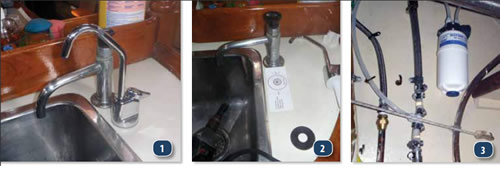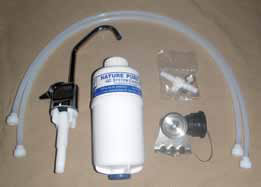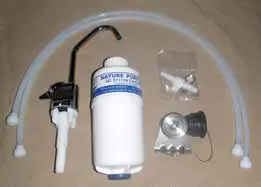Gross-tasting water is too often a sad fact of life aboard many sailboats. Even after correcting issues such as algae-filled, blackened hoses, daysailors and weekend cruisers simply don’t have the water tank turnover that full-time cruisers do, and the result is often stale, gnarly tasting water. One simple way to help transform the Hells broth of foul H2O spewing from your faucet into the maritime equivalent of a pure mountain stream is by adding a water filter or purifier to your freshwater system.

Photos by Frank Lanier
We recently tested the latest freshwater purifier to hit the market: the Nature-Pure QC2 (Quick Change) system by General Ecology Inc. (GE), a leader in drinking-water filtration and purification systems for more than 40 years. The new point-of-use water purifier is easy to use, and unlike many water-filtration systems, it wont cost you a fortune.

What We Tested
Many boat owners consider GEs Seagull IV line of water purifiers (PS, Offshore Log, Nov. 1, 1998) to be the gold standard for water-purification systems, although just as many find the $562 price tag too hard to swallow. The Nature Pure QC2 offers handy new features and a reduced price, making onboard filtration a bit more palatable.
Unlike the Seagull unit, the Nature-Pure QC2 system uses a disposable, external canister rather than an internal cartridge. The canister screws into the bottom of a stainless-steel fitting (or interface, according to the owners manual) that has an inlet and outlet on top and a non-removable bracket that can be mounted on most vertical surfaces (bulkhead, cabinet, etc.). It also has a tethered sanitary bypass connector, which is simply a knobbed plug that you can screw into the canister port, allowing you to use the freshwater system with the canister removed. When not in use, the plug screws into a holder on the side of the interface.
The QC2 comes in two styles, the basic model ($269) and the faucet model ($325); we tested the latter. They come with the same installation parts (interface, canister, 30-inch connector hoses, screws, and elbow fittings), however the faucet model also includes a faucet (with ceramic disk valve) and a plastic T installation fitting. Having a dedicated faucet for drinking water means the filter will last longer since-unlike inline filters-its not filtering water used for washing dishes, rinsing hands, etc.
The QC2 uses an Ultrafine Structured Matrix-style filter with 0.4-micron particle retention. Its advertised as being instantly effective against microbiological, chemical, and aesthetic contaminants. The company also claims that QC2 canisters are independently certified to remove waterborne, enteric pathogens-chlorine-resistant cryptosporidium and giardia, bacteria, and viruses-and that the cartridges excel in removing foul tastes, odors, and many chemicals. They are not designed to remove dissolved salts or minerals.
The QC2 system has a flow rate of 0.8 gallons per minute (gpm). The canisters should last through 800 gallons (12,800 8-ounce glasses of water), but this will vary depending on input water quality. Filters should be replaced when flow decreases noticeably or every two years, per the manufacturer. Canisters can also be easily stored or winterized: Simply remove the canister from the interface (and install the sanitary bypass connector in its place), allow the canister to air dry, then install the shipping cap that comes with the canister. For winterizing, the maker advises also adding a propylene glycol-based antifreeze to the distribution system. While certain antifreeze solutions can harm some plastic plumbing parts (PS, July 2013), GE claims that none will degrade the interfaces polypropylene cover that is used for storage.
Replacement canisters cost $111, and the interface comes with a five-year limited warranty. The QC2 system can be ordered online at www.generalecology.com or from General Ecology Europes website www.purewateronline.co.uk.
Field Testing
Testers installed the QC2 faucet model aboard our test boat, a 1978 Union 36 with a single 75-gallon stainless-steel freshwater tank. The boats potable water system is well maintained, but because it isn’t cruised full-time, the tank produced only stale-tasting water with a hint of musty rubber hose. Over the years, countless cases of bottled water had been lugged aboard, as none of the crew would willingly drink the tank water. Testers sought to determine whether the QC2 would remedy that.
We used the system during a weeklong cruise on Chesapeake Bay to see how the canister filter performed, from both a taste and operational standpoint.
Results
Testers found filter and faucet installation to be straightforward. It took about an hour to complete and required only basic tools (screwdriver, drill, and knife). The included paper pattern came in very handy when drilling the faucet hole. While not every boat owner will want to have multiple faucets installed at their galley sink, testers preferred having a dedicated drinking water faucet. The Nature Pure faucet took up minimal counter and sink space.
Testers found the system to be well constructed. The faucet operated smoothly and looked good-as far as faucets go-as it blended in with galley dcor. We particularly liked that the canister could be removed or replaced without shutting off the water system. Water flow through the canister is automatically turned off when removed, and turned on when a new canister is hand-twisted into place. This means that in a pinch, you can also use the system or faucet with no canister installed.
Water pressure from the faucet was comparable to that of the boats galley-sink faucet already installed, and wed expect that wouldnt change if the filter were installed on an existing galley faucet. The only impact on water pressure would come from the filter becoming full over time, when it nears replacement time.
The QC2-filtered water received a unanimous thumbs-up from the crew, who reported that they were unable to tell the difference between bottled water and QC2-filtered boat-tank water. Weve cruised aboard some boats where the water was filtered to the point of being so insipid tasting that it was almost undrinkable-not so with the QC2. It did a good job of removing odor and foul taste, without negatively affecting drinkability.
Bottom line
From a filtration standpoint, this is a top-of-the-line filter. It uses the same technology as the revered Seagull units and provides impressive water-filtration results at a reasonable price, particularly when the cost of bottled water (to both the wallet and the environment) are factored in. It also improves taste quality more and is more convenient for daily use on cruises than the SteriPEN (PS, September 2008) or other handheld, UV-zapping purifiers.
The maker advises changing the filter cartridge every two years. To extend the life of the filter, its a good idea to particle-filter the tank water as well. This may also improve water flow. Boat owners who do not want to add a dedicated faucet, or those who use less than 800 gallons of drinking water in two years, should opt for the less-expensive basic model, which can be fitted onto any faucet.






































Very useful – answers a lot of basic questions and helps make this concept feasible for my small sailboat.
I use a Whale foot pump at my galley sink. Will this work with foot pedal pressure?
Enjoyed the CD 30 article.Changing from sail to power this Winter,hoping to .locate a Cape ,Dory 28.with a similar supporting article.
Hoping you can guide me with info on design and sources.
Been aboard two CD28 here in MBTS harbor..proof that the CD 28 is one good choice
Would appreciate your guidance.
Regards
Jerry Jodice
Cell : 857 891 2167
Email jajodice@ ieee.org